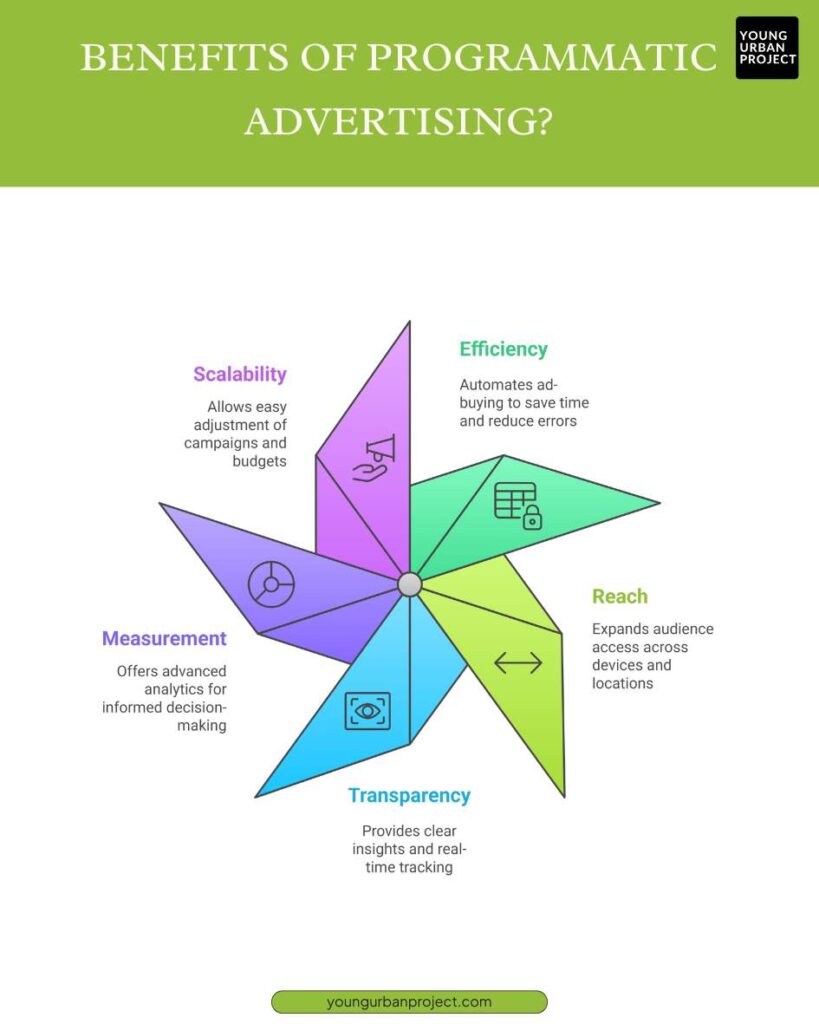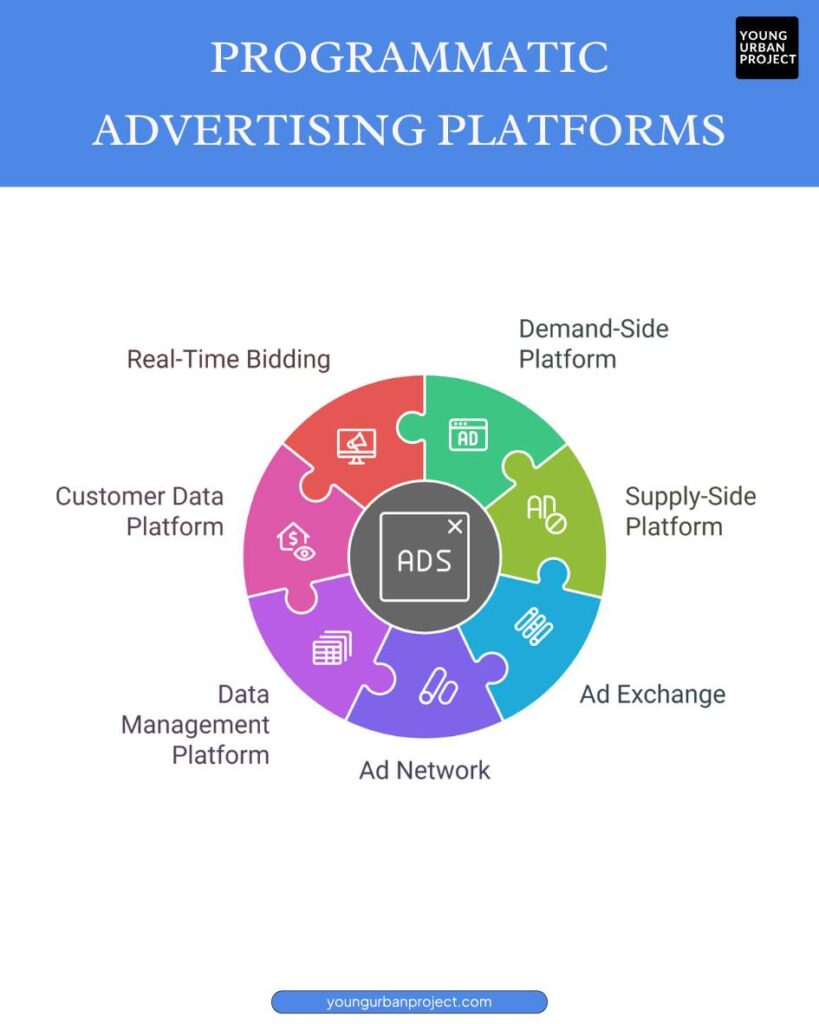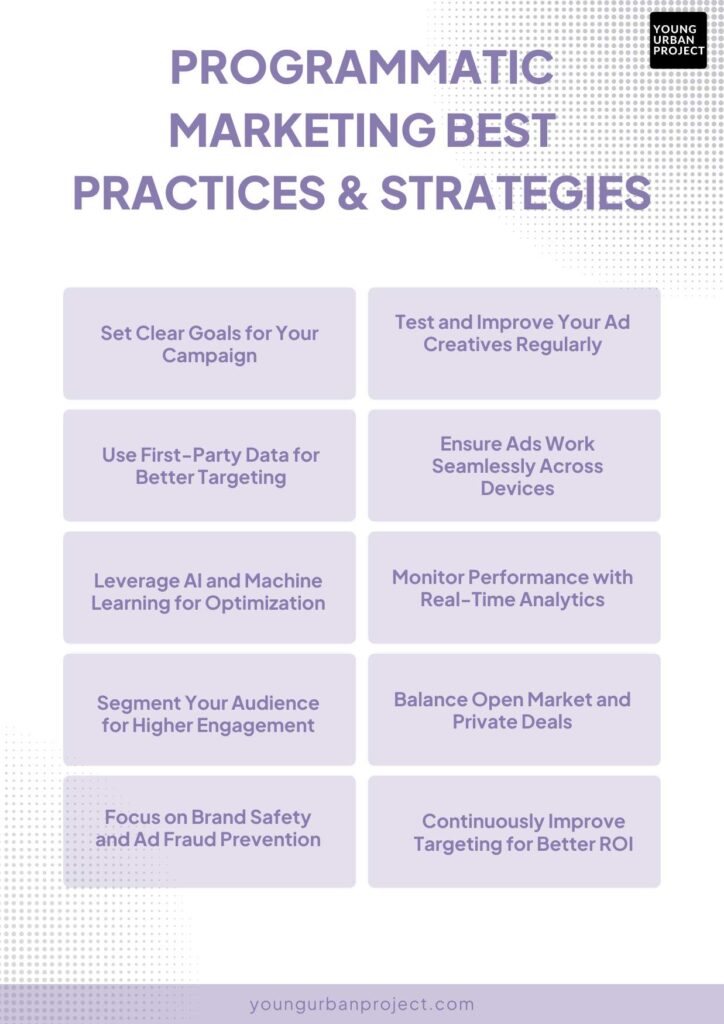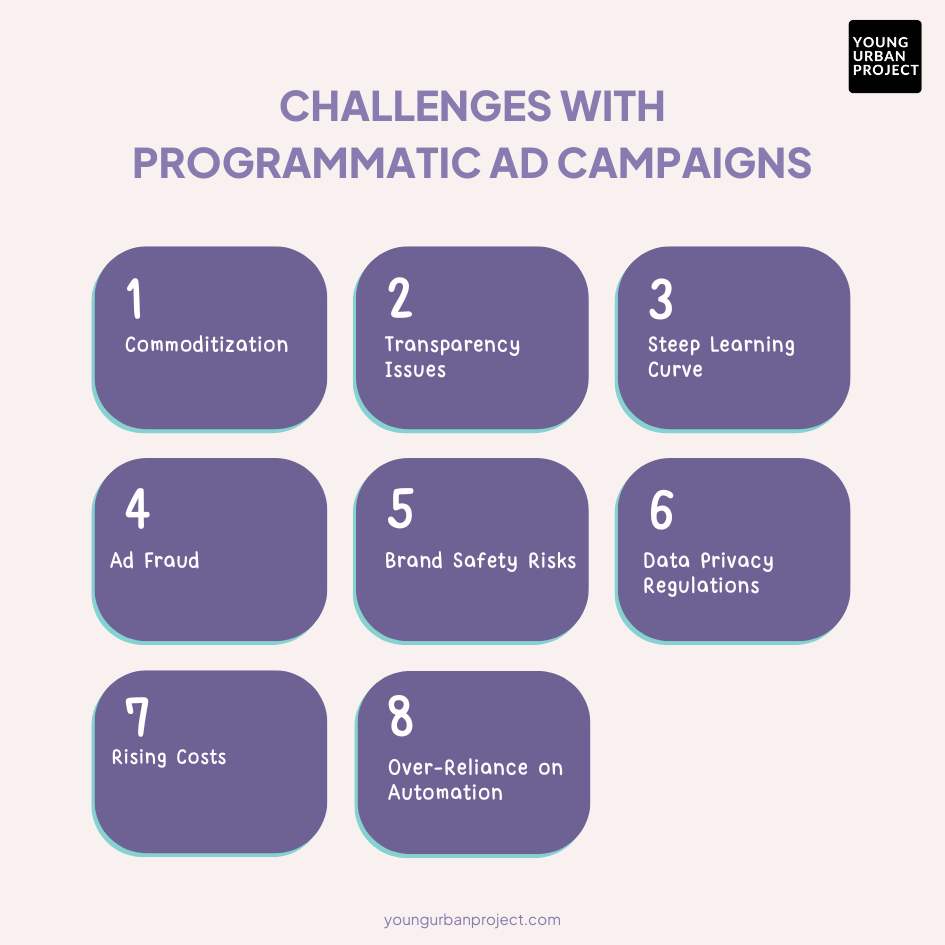Ever wonder how some ads seem to know exactly what you’re interested in? That’s the power of programmatic advertising, a smarter, automated way to buy and place ads. Instead of manually negotiating ad spots, programmatic uses technology to target the right audience at the right time, maximizing efficiency and reach. Think of it as a digital assistant for your ad campaigns, optimizing performance 24/7.
Table of Contents
With programmatic advertising, you can reach potential customers with greater precision, save time, and get better value for your ad spend. It takes the guesswork out of digital marketing by using data to make informed decisions about where and when ads should appear. Whether you’re a marketer looking to optimize your strategy or a business aiming to grow, understanding programmatic advertising is crucial in today’s competitive digital landscape. In this guide, we’ll explore how it works, why it’s essential, and how to leverage its full potential for your brand.
What is programmatic advertising?
Programmatic advertising is the automated buying and selling of digital ad space using technology and data. It replaces traditional, manual ad-buying processes with algorithms that analyze user behavior, demographics, and interests to deliver highly targeted ads in real-time. Through methods like Real-Time Bidding (RTB), ads are placed on websites, apps, or platforms that match the advertiser’s criteria, ensuring the right message reaches the right audience at the right moment. It supports various ad formats, including display, video, and native ads, and operates through platforms like Demand-Side Platforms (DSPs) and Supply-Side Platforms (SSPs).
Also read: Scope of Advertising
Why is Programmatic Advertising Essential?
Programmatic advertising is essential because it transforms digital marketing by making it faster, smarter, and more cost-effective. It allows advertisers to leverage vast amounts of data to target specific audiences with precision, reducing wasted impressions and improving ROI. The real-time nature of programmatic enables continuous optimization, ensuring campaigns perform at their best. Additionally, it provides transparency, scalability, and the ability to reach audiences across multiple devices and platforms. In a world where consumers expect personalized experiences, programmatic advertising ensures brands can deliver relevant messages efficiently, making it a must-have tool in modern marketing strategies.
Programmatic vs Display Ads
A detailed comparison of Programmatic Ads vs. Display Ads:
| Category | Programmatic Ads | Display Ads |
| Definition | Automated advertising using algorithms and data to buy and place ads in real-time across multiple platforms. | Ads (banners, videos) placed manually or via networks on websites or apps. |
| Buying Process | Automated: Ads are bought in real-time via Demand-Side Platforms (DSPs) and Supply-Side Platforms (SSPs). | Manual or Automated: Purchased through direct deals with publishers or ad networks. |
| Bidding | Real-time Bidding (RTB): Auction-based, allowing dynamic pricing based on demand and audience targeting. | Typically fixed pricing or negotiated rates for specific placements. |
| Targeting | Highly Granular: Based on user data (behavior, demographics, location, interests, device). Real-time targeting and behavior-driven. | Broader Targeting: Typically focused on demographic or contextual factors (site content). Less precise than programmatic. |
| Ad Placements | Dynamic Placement: Ads are placed across a range of websites, apps, and channels, optimized for the best performance. | Fixed Placements: Ads placed in specific, predetermined spots (e.g., banners, pop-ups) on chosen websites or apps. |
| Cost Efficiency | More Cost-Efficient: Cost is optimized via RTB and audience targeting, paying only for relevant impressions. | Less Cost-Efficient: Costs can be higher due to fixed rates and less flexibility in optimization. |
| Metrics and Optimization | Real-time Optimization: Detailed performance tracking (CTR, CPA, conversions). Ads adjusted continuously for better results. | Basic Metrics: Performance data is available, but adjustments take longer. Limited real-time optimization. |
| Transparency and Control | Greater Control: Full control over budget, audience targeting, and ad spend. Some transparency issues due to ad fraud risks. | Clearer Transparency: Direct deals with publishers offer more visibility in terms of where ads are placed and costs. |
| Flexibility | Highly Flexible: Quick changes to targeting, budget, creative formats. Ads can be adjusted in real-time based on performance. | Limited Flexibility: Changes are slower and typically require manual intervention to update creative or targeting. |
| Scalability | Highly Scalable: Easy to scale across multiple channels, devices, and geographies using automation. | Limited Scalability: Scaling requires manual intervention and more resources, making it harder to scale quickly. |
| Creative Formats | Variety of Formats: Banners, native ads, videos, interactive, and personalized ads based on real-time user data. | Standard Formats: Banner ads, sidebars, or pop-up formats, with less flexibility and personalization. |
| Audience Segmentation | Advanced Segmentation: Audience targeting is based on detailed user behavior, intent, and real-time data, allowing for precision. | Basic Segmentation: Broad categories (age, gender, geographic location) and contextual targeting based on the page content. |
| Ad Personalization | Highly Personalized: Ads are tailored based on the user’s behavior, interests, and browsing history. | Less Personalization: Ads tend to be more generic, serving the same creative to all visitors of a site. |
| Engagement | Higher Engagement: Precision targeting leads to higher relevance, improving CTR and conversion rates. | Lower Engagement: Broad targeting leads to ads being shown to a less relevant audience, resulting in lower engagement. |
| ROI (Return on Investment) | Higher ROI: Better targeting, optimization, and real-time adjustments lead to more efficient use of ad budgets. | Lower ROI: Fixed placements and less advanced targeting typically result in lower engagement and conversions. |
| Ad Fraud Risk | Higher Risk: Due to the automated nature of programmatic ads, there’s a higher chance of ad fraud or bots. | Lower Risk: Direct placements and manual buys reduce the risk of fraudulent impressions. |
| Performance Tracking | Advanced Analytics: Real-time tracking of key metrics (CTR, conversions, impressions) to refine and optimize campaigns. | Basic Analytics: Limited metrics on impressions, clicks, and basic engagement. Requires manual analysis and adjustments. |
| Control Over Placements | Less Control: Ads may be placed across various sites and platforms automatically, limiting publisher-specific placement control. | Greater Control: With direct deals, advertisers have full visibility and control over where their ads appear. |
| Usage Context | Ideal for targeted, data-driven campaigns across multiple platforms and devices. Works well for performance-driven goals. | Best for brand awareness campaigns where broad visibility is needed. Suitable for less targeted campaigns or smaller budgets. |
| Example of Platforms | Google Display Network, The Trade Desk, MediaMath, Xandr. | Google Display Network, AdRoll, BuySellAds. |
Also read: Marketing vs Advertising: Key differences with real-world examples
Programmatic vs Digital Advertising
Here’s a detailed comparison between Programmatic Advertising and Digital Advertising:
| Category | Programmatic Advertising | Digital Advertising |
| Definition | Automated buying and placement of ads using algorithms, real-time bidding, and data to target specific audiences. | Broader term encompassing all types of online advertising, including display ads, search ads, social media ads, etc. |
| Buying Process | Automated & Data-Driven: Uses software platforms (DSPs and SSPs) for ad buying and real-time bidding. | Manual & Automated: Can be bought directly from publishers or through ad networks, and may be automated or manual. |
| Ad Placement | Dynamic Placement: Ads are placed programmatically across multiple channels and platforms, often in real-time. | Fixed or Network-Based: Ads can be placed on specific websites, social platforms, or ad networks manually or through automated processes. |
| Targeting | Highly Granular Targeting: Based on data such as demographics, location, browsing behavior, device, time of day, and more. | Broad or Basic Targeting: Includes targeting based on simple criteria (e.g., demographics, keywords, or interests). |
| Bidding | Real-Time Bidding (RTB): Ads are bought in real-time auctions where advertisers bid for ad impressions. | Fixed Pricing or Auction: Ads may be bought at fixed rates or through other auction-based methods (e.g., Google Ads). |
| Control and Transparency | Limited Transparency: May involve hidden fees, ad fraud, and less visibility on where the ads are placed. | More Transparency: Direct ad buys offer clearer placements and control over which sites or platforms ads appear on. |
| Creativity and Formats | Variety and Personalization: Ads can include banners, videos, native ads, and more, with real-time customization based on user data. | Fixed Formats: Common ad types include banners, text ads, display ads, video ads, and sponsored content. |
| Cost Efficiency | Cost-Effective: Ad spend is optimized through automation, targeting, and bidding. Can adjust in real-time to ensure better value. | Variable Efficiency: Costs depend on the platform and method of buying. Often involves fixed rates or negotiation with publishers. |
| Metrics and Reporting | Advanced Metrics: In-depth, real-time performance tracking such as click-through rate (CTR), cost-per-click (CPC), cost-per-acquisition (CPA), and return on investment (ROI). | Basic Metrics: Typically includes impressions, clicks, and conversions. More basic reporting with less granular data. |
| Ad Fraud Risk | Higher Risk: Programmatic ads are vulnerable to fraud and bot traffic, though measures are being taken to mitigate this. | Lower Risk: With direct placements and manual buys, the risk of fraud is typically lower. |
| Audience Reach | Wider & More Precise Reach: Reaches users across multiple devices and channels, utilizing data for highly targeted audience segments. | Broader Reach: Can target audiences based on specific platforms but may lack the precision offered by programmatic. |
| Real-Time Optimization | Immediate Adjustments: Ads can be optimized in real-time based on performance data, ensuring efficiency. | Slower Optimization: Changes require manual adjustments, which can take longer to implement. |
| Scalability | Highly Scalable: Easily scalable across channels, devices, and geographies using automation. | Limited Scalability: Scaling is often more challenging due to the manual nature of some campaigns. |
| Ad Placement Control | Less Control: Ads can be placed across various sites automatically, with limited visibility into specific placements. | More Control: Advertisers can directly control where their ads appear, especially in direct buys. |
| Campaign Flexibility | Flexible: Immediate changes to targeting, creatives, and budgeting can be made, allowing for dynamic campaign management. | Less Flexible: Changes often require manual intervention, especially in traditional advertising methods. |
| Ad Channels | Cross-Channel: Ads can appear across multiple platforms (web, mobile, video, social, connected TV, etc.), often simultaneously. | Platform-Specific: Ads tend to be more platform-dependent, such as Google Ads for search or Facebook Ads for social media. |
| Targeting Precision | Highly Precise: Ads are served to the most relevant audience in real-time based on a wide array of data points. | Less Precise: Targeting may be based on broader criteria, such as interests or geographic location, rather than individual behaviors. |
| Automation Level | Fully Automated: The entire ad buying and placement process is handled by algorithms with little to no human intervention. | Partially Automated: Digital advertising can be manual (direct buys) or automated (e.g., Google Ads), but not as fully automated as programmatic. |
| Example Platforms | Google Display Network, The Trade Desk, MediaMath, Xandr, AppNexus. | Google Ads, Facebook Ads, Instagram Ads, LinkedIn Ads, traditional display networks. |
| Use Cases | Highly Targeted Campaigns: Ideal for advertisers seeking to reach specific audiences with data-driven insights in real-time. | Brand Awareness & General Reach: Best suited for broad campaigns aimed at raising awareness or engaging a larger audience. |
What are the benefits of programmatic advertising?

1. Efficiency
Programmatic advertising automates the ad-buying process, eliminating the need for manual negotiations and placements. It uses algorithms to target the right audience, ensuring ads are shown to the most relevant users. This saves time, reduces human error, and minimizes wasted ad spend. By streamlining the process, advertisers can focus on strategy while the system handles execution, making campaigns more cost-effective and productive.
2. Reach
Programmatic advertising allows advertisers to access a vast network of websites, apps, and platforms. It enables campaigns to run across multiple devices, including mobile, desktop, and tablets, ensuring maximum audience reach. Whether targeting locally or globally, programmatic ensures ads are seen by the right people in the right places, expanding brand visibility and engagement without the limitations of traditional ad-buying methods.
3. Transparency
Programmatic advertising provides clear insights into where ads are placed and how budgets are spent. Advertisers can track performance metrics in real-time, ensuring full visibility into campaign effectiveness. This transparency helps build trust, as advertisers know exactly where their ads appear and how their money is being used. It also allows for quick adjustments to optimize campaigns and avoid low-performing placements.
4. Measurement
Programmatic advertising offers advanced tracking and analytics to measure campaign performance. Key metrics like impressions, clicks, conversions, and ROI are monitored in real-time. This data-driven approach enables advertisers to make informed decisions, optimize campaigns, and improve results. By understanding what works and what doesn’t, advertisers can refine their strategies to achieve better outcomes and maximize their return on investment.
5. Scalability
Programmatic advertising is highly scalable, making it suitable for both small and large campaigns. Advertisers can easily adjust budgets, targeting, and ad formats to scale campaigns up or down as needed. It supports multiple platforms, devices, and ad types, allowing brands to expand their reach without compromising efficiency. This flexibility ensures campaigns can grow alongside business goals, delivering consistent results.
Also read: 8 Types Of Advertising
Programmatic Advertising Platforms

1. Demand-Side Platform (DSP)
A Demand-Side Platform (DSP) is a tool advertisers use to buy digital ad space automatically. It allows brands to bid on ad placements in real time, ensuring their ads reach the right audience. DSPs analyze user data to target specific demographics, behaviors, and interests. Popular DSPs include Google DV360, The Trade Desk, and Amazon DSP, helping advertisers optimize ad spend efficiently.
2. Supply-Side Platform (SSP)
A Supply-Side Platform (SSP) is used by publishers to sell ad space to advertisers. It connects to multiple DSPs, ensuring that ad inventory is sold to the highest bidder in real-time. SSPs help publishers maximize revenue by making their ad space available to a broad range of advertisers. Examples include Google Ad Manager, PubMatic, and Magnite, which provide publishers with control over pricing, ad quality, and audience reach.
3. Ad Exchange
An Ad Exchange is a digital marketplace where advertisers and publishers buy and sell ad inventory in real time through automated bidding. It acts as a bridge between DSPs and SSPs, allowing for efficient transactions. Ad exchanges enable advertisers to access a wide range of publishers while ensuring publishers get the best price for their ad spaces. Examples include Google AdX, OpenX, and Xandr.
4. Ad Network
An Ad Network collects ad inventory from publishers and sells it to advertisers. Unlike ad exchanges, which use real-time bidding, ad networks group inventory into categories based on audience, industry, or placement type. They offer a more structured way of buying ads, often at fixed prices. Examples include Google Display Network, Media.net, and Taboola, which help advertisers access a large pool of websites efficiently.
5. Data Management Platform (DMP)
A Data Management Platform (DMP) collects, organizes, and analyzes user data from various sources, including websites, apps, and CRM systems. Advertisers use DMPs to segment audiences based on demographics, interests, and behaviors, improving targeting precision. By integrating with DSPs and SSPs, DMPs help advertisers create more personalized and effective campaigns. Examples include Adobe Audience Manager and Salesforce DMP.
6. Customer Data Platform (CDP)
A Customer Data Platform (CDP) is a tool that collects and unifies first-party customer data from various sources, creating a single, detailed customer profile. Unlike a DMP, which focuses on anonymous data, a CDP provides persistent, personalized insights for long-term marketing strategies. Brands use CDPs to improve customer experiences, retention, and targeted advertising. Examples include Segment, BlueConic, and Treasure Data.
7. Real-Time Bidding (RTB)
Real-Time Bidding (RTB) is an automated auction process where advertisers bid on available ad impressions in milliseconds. When a user visits a website, an ad request is sent to multiple DSPs, triggering a bidding war. The highest bid wins, and the ad is displayed instantly. RTB ensures cost efficiency, better targeting, and improved ad performance. It’s widely used in programmatic advertising to maximize ad effectiveness.
Also read: Performance Marketing vs Paid Advertising
Programmatic Marketing Best Practices & Strategies

1. Set Clear Goals for Your Campaign
Before running a programmatic ad campaign, define what you want to achieve—brand awareness, lead generation, sales, or customer engagement. Having clear objectives helps in selecting the right audience, ad placements, and bidding strategies. It also allows you to measure success effectively and make necessary adjustments for better performance. Without a defined goal, ad spend can go to waste.
2. Use First-Party Data for Better Targeting
First-party data, collected directly from your customers, is the most reliable source for personalized advertising. It includes website interactions, purchase history, and customer preferences. By using this data, you can create highly targeted campaigns, improve customer engagement, and reduce reliance on third-party cookies. Integrating first-party data with a Customer Data Platform (CDP) or Data Management Platform (DMP) enhances audience segmentation and campaign effectiveness.
3. Leverage AI and Machine Learning for Optimization
Artificial Intelligence (AI) and Machine Learning (ML) can analyze vast amounts of data to optimize ad performance in real time. AI-powered algorithms adjust bids, personalize creatives, and predict the best-performing ad placements. These technologies help brands maximize ROI by ensuring ads reach the right people at the right time, reducing wasted impressions and improving overall campaign efficiency.
4. Segment Your Audience for Higher Engagement
Not all customers respond to the same ad. Audience segmentation divides users into groups based on behavior, interests, demographics, or location, allowing for more personalized messaging. Segmented campaigns perform better because they deliver relevant ads to the right people, increasing engagement and conversion rates. Platforms like DMPs and CDPs help in creating precise audience segments.
5. Focus on Brand Safety and Ad Fraud Prevention
Programmatic advertising offers massive reach, but it also comes with risks like ad fraud and placement on inappropriate websites. To protect your brand, use whitelists, blacklists, and brand safety tools like IAS or DoubleVerify. Private marketplace (PMP) deals with trusted publishers can also ensure high-quality ad placements. Regular monitoring helps prevent reputational damage and ensures ad spend is used effectively.
6. Test and Improve Your Ad Creatives Regularly
The success of an ad campaign depends on creatives that capture attention. A/B testing different ad designs, headlines, and calls-to-action (CTAs) helps determine what resonates most with your audience. Regularly updating creatives keeps campaigns fresh and engaging. AI tools can also suggest creative variations based on user behavior, maximizing performance.
7. Ensure Ads Work Seamlessly Across Devices
Consumers switch between multiple devices—smartphones, tablets, and desktops—before making a purchase. A cross-device strategy ensures a consistent ad experience, improving brand recall and engagement. Use responsive ad formats and track user interactions across devices to optimize performance. Cross-device measurement tools help understand the full customer journey, leading to better retargeting strategies.
8. Monitor Performance with Real-Time Analytics
Real-time reporting allows advertisers to track how their campaigns perform instantly. Metrics like click-through rate (CTR), conversion rate, and cost per acquisition (CPA) provide insights into what’s working and what needs improvement. Platforms like Google DV360, The Trade Desk, and Adobe Advertising Cloud offer advanced analytics to refine campaigns dynamically, ensuring budget is allocated to high-performing ads.
9. Balance Open Market and Private Deals
The open market provides access to a large inventory of ad placements, while private marketplaces (PMPs) offer premium inventory with more control. A balanced approach helps reach wider audiences while ensuring brand safety. PMPs may have higher costs but provide better transparency and ad quality. Using a mix of both ensures cost efficiency and maximized reach.
10. Continuously Improve Targeting for Better ROI
Consumer behavior changes over time, so targeting strategies should be regularly refined. Analyzing campaign data helps identify patterns and adjust audience segments for better accuracy. Testing different targeting methods—contextual targeting, behavioral targeting, or geo-targeting—improves ad relevance. Staying updated with industry trends ensures your ads remain competitive and deliver better return on investment (ROI).
Also read: Importance of Advertising in Business
Challenges that Could Arise with Programmatic Ad Campaigns

1. Commoditization
Programmatic advertising automates ad buying, making it easier for brands to compete. But this also means that many ads look and feel the same. With so many advertisers using similar strategies, standing out becomes harder. To avoid this, brands need strong creatives, better targeting, and a unique brand message. Personalization and innovative ad formats can help break through the noise.
2. Transparency Issues
Programmatic advertising involves multiple platforms, making it hard to track where ads appear and how budgets are spent. Some advertisers struggle with hidden fees, fraudulent clicks, or low-quality placements. Working with trusted platforms, using ads.txt, and demanding full transparency from partners can help. Regular monitoring and detailed reporting ensure ad budgets are spent effectively on real audiences.
3. Steep Learning Curve
Programmatic advertising is complex. It involves multiple platforms, algorithms, and bidding strategies. New advertisers often find it overwhelming. Understanding demand-side platforms (DSPs), data management, and audience targeting takes time. Brands need skilled professionals or agencies to handle campaigns effectively. Continuous learning, staying updated with trends, and experimenting with small budgets can help brands master programmatic advertising.
4. Ad Fraud
Fraudsters use bots to generate fake clicks and impressions, wasting ad budgets. Invalid traffic can inflate metrics, making campaigns look successful when they’re not. Advertisers must use fraud detection tools, work with reputable platforms, and monitor campaign data regularly. Choosing premium publishers and private marketplace (PMP) deals can also reduce the risk of fraud.
5. Brand Safety Risks
Without proper controls, ads may appear on inappropriate or low-quality websites. This can damage a brand’s reputation. For example, a luxury fashion ad appearing on a fake news site could harm credibility. Advertisers should use blacklists, whitelists, and contextual targeting to ensure ads appear in the right places. Choosing brand-safe ad networks helps protect image and trust.
6. Data Privacy Regulations
Stricter privacy laws like GDPR and CCPA limit how user data is collected and used. Many browsers also block third-party cookies, making it harder to track and target users. Advertisers must focus on first-party data, build direct customer relationships, and use privacy-compliant targeting methods. Transparency in data collection and ethical marketing practices are essential.
7. Rising Costs
As more brands invest in programmatic advertising, competition increases. This drives up costs, especially for premium ad placements. Small businesses may struggle to compete with big brands that have larger budgets. To control spending, advertisers should set clear bid limits, optimize audience targeting, and test different strategies to find the most cost-effective approach.
8. Over-Reliance on Automation
While automation makes programmatic advertising efficient, it’s not foolproof. If campaigns run without proper monitoring, they may waste budget on low-quality traffic. Advertisers should regularly review performance data, adjust targeting, and refine creatives. A mix of automation and human expertise ensures campaigns remain effective and aligned with business goals.
Also read: Top Advertising Agencies in India
Programmatic Advertising Examples
1. Audi – Predictive Advertising for Personalized Car Promotion
Audi utilized programmatic advertising to enhance its car customization experience. By analyzing data from their car configuration tool, Audi created dynamic ads tailored to individual user preferences. This strategy led to:
✔ 2X higher efficiency compared to previous campaigns
✔ Increased engagement through hyper-targeted messaging
📌 Source: Target Video
2. Intercontinental Hotels Group (IHG) – Driving Direct Bookings
To compete with third-party booking sites, IHG launched a programmatic campaign emphasizing the advantages of booking directly through its platform. The campaign successfully:
✔ Redirected more traffic to IHG’s own booking channels
✔ Increased customer loyalty and direct revenue
📌 Source: Publift
3. Campbell’s – Boosting Engagement with Targeted Recipes
During the pandemic, Campbell’s leveraged programmatic advertising to re-engage customers by displaying recipe-based ads on relevant websites. The campaign achieved:
✔ 4X higher click-through rate (CTR) than standard display ads
✔ 17.2X peak CTR compared to industry benchmarks
📌 Source: Agility Ads
4. Auto Trader – Optimizing Audience Targeting
Auto Trader partnered with AppNexus to implement a demand-side platform (DSP) for reaching high-value audiences. By refining its targeting strategy, the company:
✔ Reduced cost-per-acquisition (CPA) by over 90%
✔ Saved 3+ hours daily in manual campaign management
📌 Source: Agility Ads
5. CMC Markets – Timely Ads Based on Real-World Events
Following unexpected British General Election results, CMC Markets launched a responsive programmatic advertising campaign. By aligning ads with real-time political events, the campaign:
✔ Captured audience attention at the perfect moment
✔ Increased brand visibility through witty, timely ads
📌 Source: Target Video
Conclusion
Programmatic advertising has transformed the way brands reach their audiences, making digital marketing more efficient, data-driven, and scalable. By automating the buying process, advertisers can serve highly targeted ads in real time, maximizing impact while reducing wasted spend.
Despite its challenges—such as transparency concerns and a learning curve—programmatic advertising offers significant advantages, including better audience insights, cross-device reach, and real-time performance tracking. Businesses that adopt best practices, leverage AI-powered tools, and stay updated on industry trends can optimize their ad campaigns for greater efficiency and ROI.
As digital marketing evolves, programmatic advertising will continue to be a vital tool for advertisers looking to stay competitive. By understanding its platforms, strategies, and challenges, businesses can harness its full potential and achieve meaningful results in an increasingly automated advertising landscape.
Also read: What is Advertising Copy?
FAQs
1. How does programmatic advertising work?
Programmatic advertising uses computers and AI to buy and sell ad space online. Advertisers use tools (DSPs) to bid for ad spots, and publishers use tools (SSPs) to sell their ad space. This helps show ads to the right people at the right time.
2. What’s the difference between programmatic advertising and display advertising?
Display advertising is just regular online ads like banners or videos. Programmatic advertising uses computers and data to automatically place those ads in the best spots. It’s faster, cheaper, and more targeted than regular display ads.
3. Is programmatic advertising only for big brands?
No, businesses of all sizes can use programmatic advertising. Big brands might spend more, but small and medium businesses can also use it to run ads that fit their budget and target the right audience.
4. What’s the role of AI in programmatic advertising?
AI helps make programmatic advertising smarter. It looks at user data, predicts what people might do, and adjusts ad campaigns in real-time. This means better ads, more clicks, and less wasted money.
5. What are some key metrics to measure programmatic ad success?
Important things to track include:
- Click-through rate (CTR): How many people click on your ad.
- Cost per acquisition (CPA): How much it costs to get a customer.
- Conversion rate: How many people take the desired action.
- Return on ad spend (ROAS): How much money you make compared to what you spend.
- Ad viewability: Whether your ad is actually seen.
- Engagement rates: How people interact with your ad.
6. How can I make sure my programmatic ads don’t show up on bad websites?
To keep your ads safe, you can:
- Use whitelists (approved websites) and blacklists (blocked websites).
- Use tools to check where your ads are shown.
- Work with trusted ad platforms.
- Regularly check where your ads appear to avoid bad sites.

